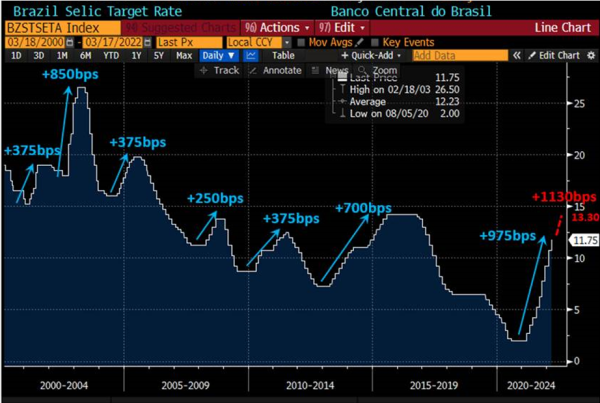Summary
Brazil’s current tightening cycle is the most extensive since 2000 – is it already hurting the country’s growth outlook? Some EMs stayed on hold, but can inflation surprises in Thailand challenge the central bank’s wait and see approach?
U.S. Fed Rate Hikes
Global rate hikes continue to pile up. In developed markets (DM), the U.S. Federal Reserve (Fed) initiated its tightening cycle yesterday with a 25bps move, and signaled a 25bps hike at every meeting in 2022. The Bank of England raised its policy rate to 0.75% this morning to deal with the energy shock. In emerging markets (EM), Brazil continued to tighten at a brisk pace – delivering the expected 100bps rate hike yesterday – as inflation pressures show few signs of abating.
Brazil Rate Hikes and Growth
The current tightening cycle in Brazil is already the most extensive since 2000 (see chart below), and the local swap curve prices in at least 160bps of additional hikes in May and June. Brazil’s very high real policy rates (based on expected inflation) was a key factor underpinning local bonds’ recent performance – the third highest total return so far this year (7.52% U.S. dollar-unhedged, J.P. Morgan’s GBI-EM Brazil Index). However, the larger than expected sequential contraction of Brazil’s economic activity in January is a stark reminder that policies (even the good ones) have side effects. In this case, the side effect is the deteriorating near-term growth outlook. The consensus currently expects Brazil to expand by mere 0.5% in real terms in 2022, and the risks are clearly to the downside (some survey participants expect recession).
EM Interest Rate Outlook
We often say that “EM is not a monolith”, and some central banks stayed on the sidelines this week. Indonesia chose not to match the Fed’s hike, arguing that “fundamental” price pressures are still under control. The Hungarian central bank is also in waiting mode, evaluating the situation after aggressive frontloading in the previous months. Turkey – thankfully – also stayed on hold (=no more rate cuts), but its policy setup remains extremely convoluted, and the central bank now argues that price pressures will subside only when the conflict between Russia and Ukraine is over. Finally, we keep a close eye on central banks in Russia and Thailand. In Russia, the expectation is for a pause after the key rate was raised to 20%. In Thailand, core inflation is nearly five standard deviations higher than the 5-year average, and headline inflation is now above the target range. Can the central bank afford to treat these developments as transitory without facing the market implications? Stay tuned!
Chart at a Glance: Brazil’s Most Extensive Hiking Cycle Has Further to Run

Source: Bloomberg LP
This article originally published by VanEck on March 17, 2022.
PMI – Purchasing Managers’ Index: economic indicators derived from monthly surveys of private sector companies. A reading above 50 indicates expansion, and a reading below 50 indicates contraction; ISM – Institute for Supply Management PMI: ISM releases an index based on more than 400 purchasing and supply managers surveys; both in the manufacturing and non-manufacturing industries; CPI – Consumer Price Index: an index of the variation in prices paid by typical consumers for retail goods and other items; PPI – Producer Price Index: a family of indexes that measures the average change in selling prices received by domestic producers of goods and services over time; PCE inflation – Personal Consumption Expenditures Price Index: one measure of U.S. inflation, tracking the change in prices of goods and services purchased by consumers throughout the economy; MSCI – Morgan Stanley Capital International: an American provider of equity, fixed income, hedge fund stock market indexes, and equity portfolio analysis tools; VIX – CBOE Volatility Index: an index created by the Chicago Board Options Exchange (CBOE), which shows the market’s expectation of 30-day volatility. It is constructed using the implied volatilities on S&P 500 index options.; GBI-EM – JP Morgan’s Government Bond Index – Emerging Markets: comprehensive emerging market debt benchmarks that track local currency bonds issued by Emerging market governments; EMBI – JP Morgan’s Emerging Market Bond Index: JP Morgan’s index of dollar-denominated sovereign bonds issued by a selection of emerging market countries; EMBIG – JP Morgan’s Emerging Market Bond Index Global: tracks total returns for traded external debt instruments in emerging markets.
The information presented does not involve the rendering of personalized investment, financial, legal, or tax advice. This is not an offer to buy or sell, or a solicitation of any offer to buy or sell any of the securities mentioned herein. Certain statements contained herein may constitute projections, forecasts and other forward looking statements, which do not reflect actual results. Certain information may be provided by third-party sources and, although believed to be reliable, it has not been independently verified and its accuracy or completeness cannot be guaranteed. Any opinions, projections, forecasts, and forward-looking statements presented herein are valid as the date of this communication and are subject to change. The information herein represents the opinion of the author(s), but not necessarily those of VanEck.
Investing in international markets carries risks such as currency fluctuation, regulatory risks, economic and political instability. Emerging markets involve heightened risks related to the same factors as well as increased volatility, lower trading volume, and less liquidity. Emerging markets can have greater custodial and operational risks, and less developed legal and accounting systems than developed markets.
All investing is subject to risk, including the possible loss of the money you invest. As with any investment strategy, there is no guarantee that investment objectives will be met and investors may lose money. Diversification does not ensure a profit or protect against a loss in a declining market. Past performance is no guarantee of future performance.

